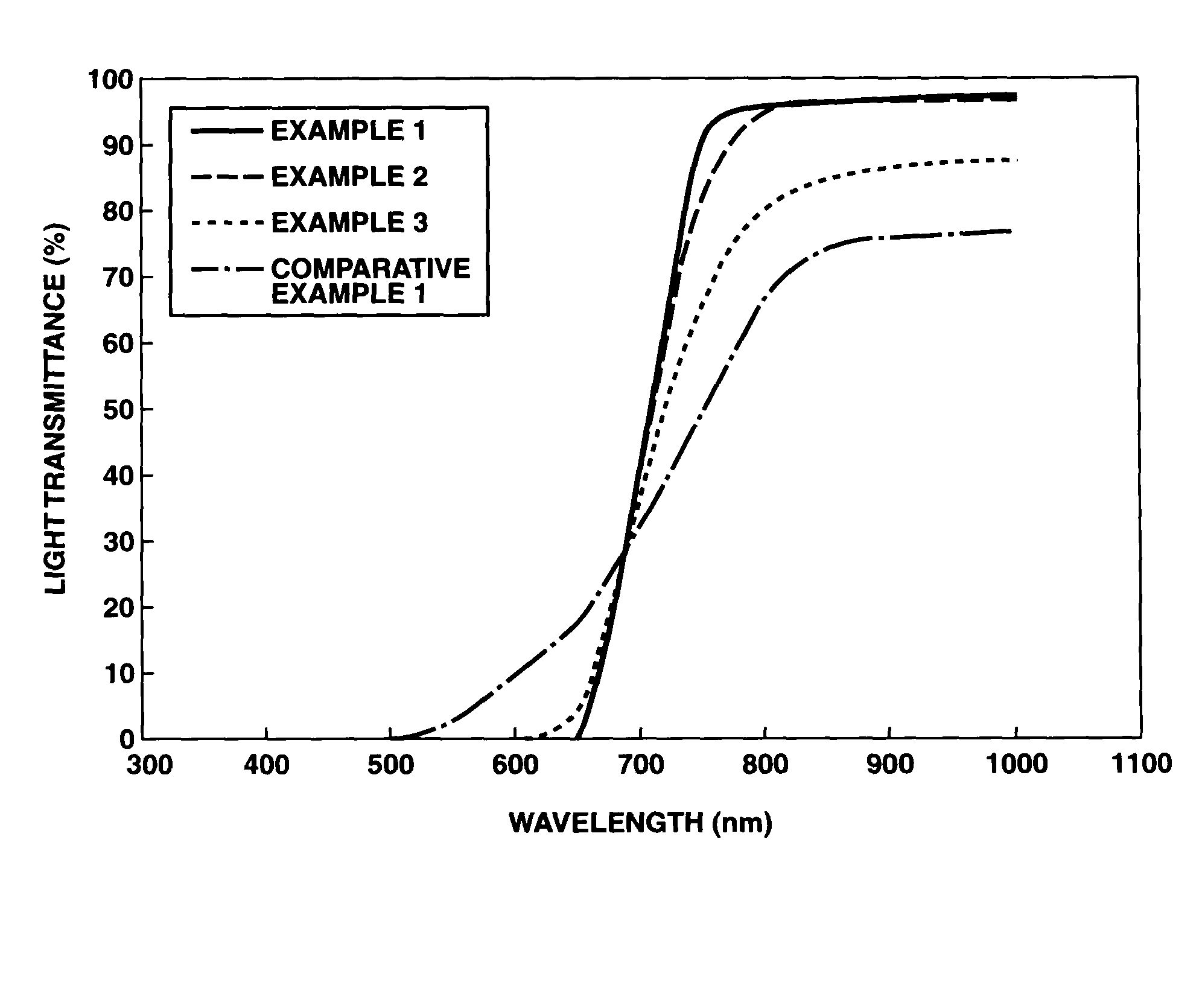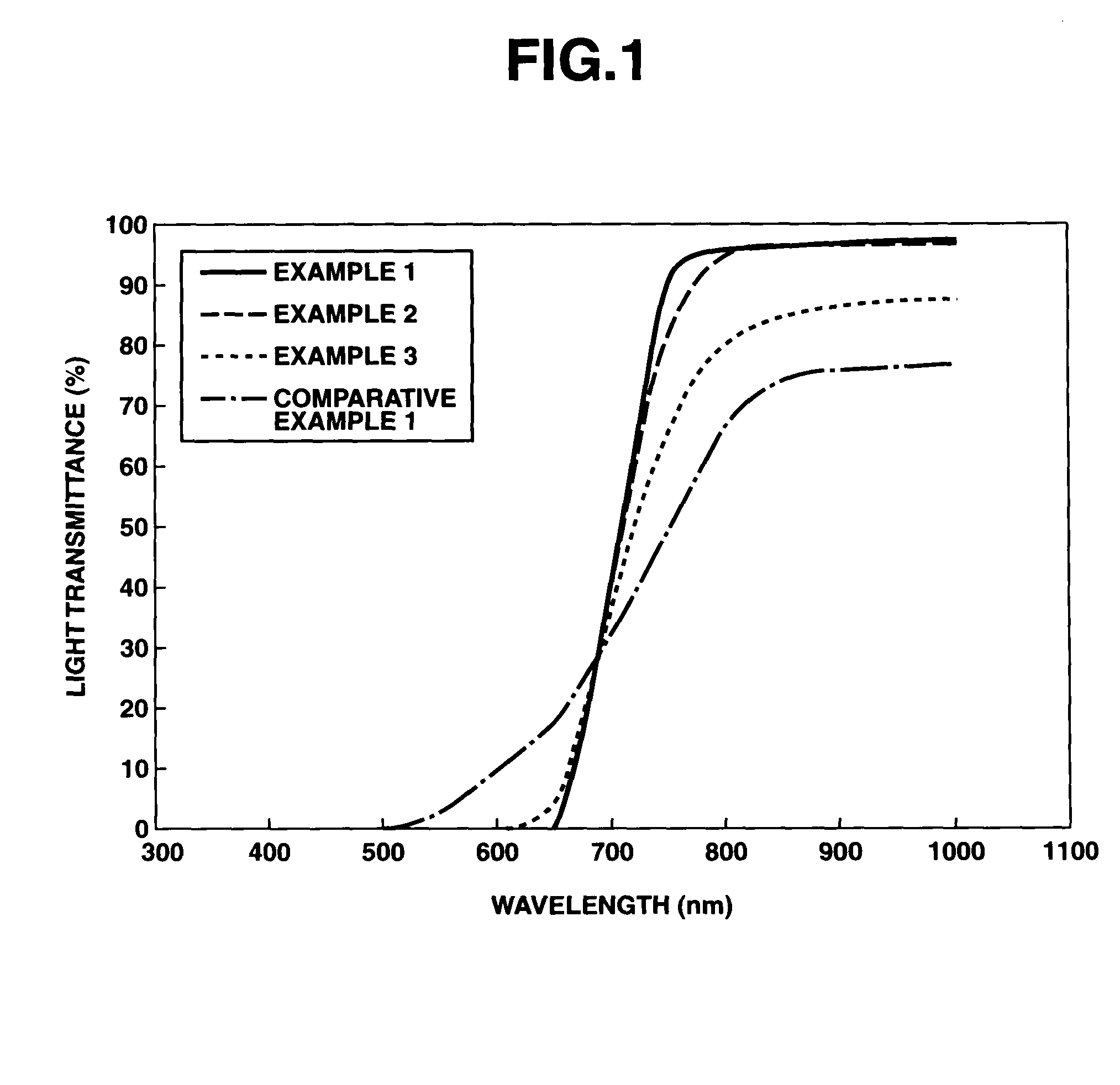Visible light-shielding silicone rubber composition, cured product, and optoelectronic device
- Summary
- Abstract
- Description
- Claims
- Application Information
AI Technical Summary
Benefits of technology
Problems solved by technology
Method used
Image
Examples
example 1
[0036]A silicone rubber composition was prepared by combining 100 parts of a polysiloxane of the formula:
wherein k=68 and m=30, having a viscosity of ˜4,000 mPa-s, with an organohydrogenpolysiloxane of the formula:
wherein k=10 and m=8, in an amount to give 1.5 moles of SiH groups per mole of total vinyl groups in the polysiloxane, 0.05 part of an octyl alcohol-modified chloroplatinic acid solution, and 2 parts of Kayaset Black 151-H (Nippon Kayaku Co., Ltd.) and thoroughly agitating them. The composition was heat molded at 100° C. for 4 hours into a cured part. It was measured for tensile strength and hardness (Type A spring tester) according to JIS K-6301. Also, the cured part having a thickness of 1 mm was measured for light transmittance by a transmittance tester V-4100 (Hitachi Ltd.). At this time, the light transmittance in wavelength 650 nm was 0%, and the light transmittance in wavelength 800 nm was 96%.
[0037]A bare light-emitting diode member was filled with the composition,...
example 2
[0038]A silicone rubber composition was prepared by combining 100 parts of a polysiloxane of the formula:
wherein k=83 and m=15, having a viscosity of ˜2,000 mPa-s, with an organohydrogenpolysiloxane of the formula:
wherein k=10 and m=8, in an amount to give 1.5 moles of SiH groups per mole of total vinyl groups in the polysiloxane, 0.05 part of an octyl alcohol-modified chloroplatinic acid solution, and 2 parts of Kayaset Black 151-H (Nippon Kayaku Co., Ltd.) and thoroughly agitating them. The composition was heat molded at 100° C. for 4 hours into a cured part (thickness: 1.0 mm). It was similarly measured for tensile strength and hardness according to JIS K-6301 and for light transmittance. At this time, the light transmittance in wavelength 650 nm was 0%, and the light transmittance in wavelength 800 nm was 95%.
[0039]A bare LED member was filled with the composition, which was heated at 100° C. for 4 hours. The sample was subjected to thermal cycling between −40° C. for 30 minutes...
example 3
[0040]A silicone rubber composition was prepared by combining 100 parts of a polysiloxane of the formula:
wherein k=68 and m=30, having a viscosity of ˜4,000 mPa-s, with an organohydrogenpolysiloxane of the formula:
wherein k=10 and m=8, in an amount to give 1.5 moles of SiH groups per mole of total vinyl groups in the polysiloxane, 0.05 part of an octyl alcohol-modified chloroplatinic acid solution, and 2 parts of azo-chrome dye PC Black 006P (Nippon Kayaku Co., Ltd.) and thoroughly agitating them. The composition was heat molded at 100° C. for 4 hours into a cured part (thickness: 1.0 mm). It was similarly measured for tensile strength and hardness according to JIS K-6301 and for light transmittance. At this time, the light transmittance in wavelength 650 nm was 5%, and the light transmittance in wavelength 800 nm was 81%.
[0041]A bare LED member was filled with the composition, which was heated at 100° C. for 4 hours. The sample was subjected to thermal cycling between −40° C. for 3...
PUM
| Property | Measurement | Unit |
|---|---|---|
| Temperature | aaaaa | aaaaa |
| Fraction | aaaaa | aaaaa |
| Fraction | aaaaa | aaaaa |
Abstract
Description
Claims
Application Information
 Login to View More
Login to View More - R&D
- Intellectual Property
- Life Sciences
- Materials
- Tech Scout
- Unparalleled Data Quality
- Higher Quality Content
- 60% Fewer Hallucinations
Browse by: Latest US Patents, China's latest patents, Technical Efficacy Thesaurus, Application Domain, Technology Topic, Popular Technical Reports.
© 2025 PatSnap. All rights reserved.Legal|Privacy policy|Modern Slavery Act Transparency Statement|Sitemap|About US| Contact US: help@patsnap.com



